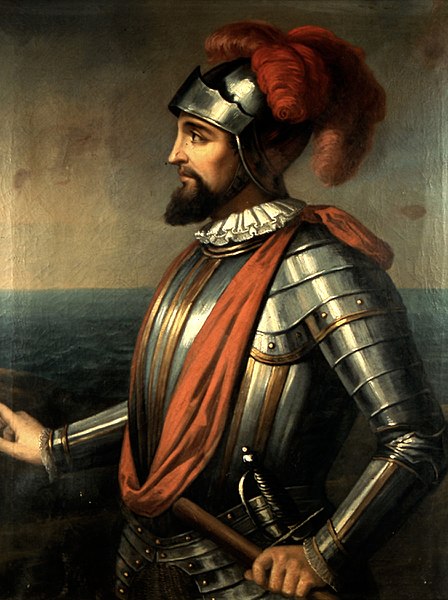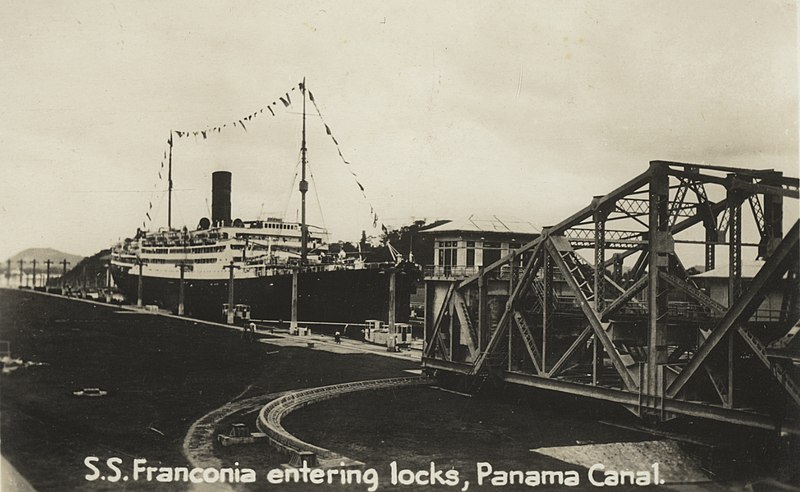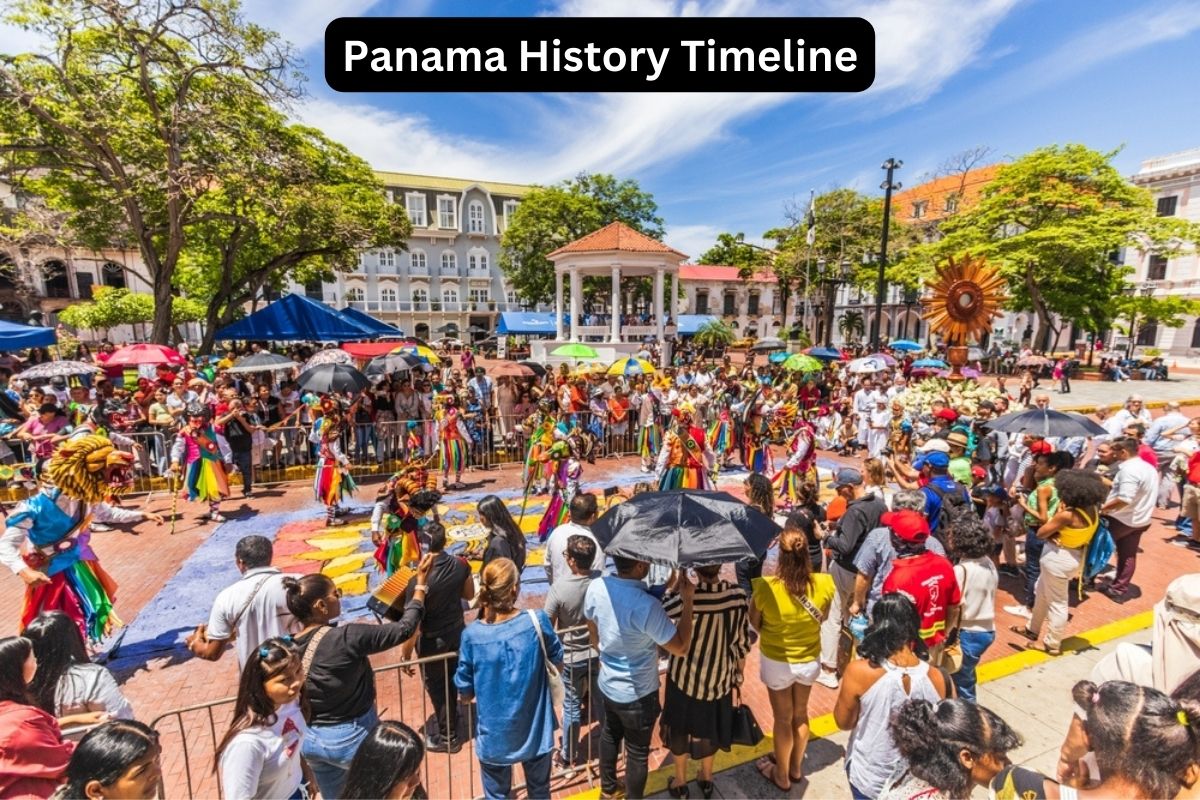Panama’s rich history is a tapestry woven with threads of indigenous cultures, Spanish colonialism, and international influence.
From its pre-Colombian roots to its pivotal role in global trade with the construction of the Panama Canal, the country’s story is one of resilience, innovation, and cultural diversity.
This article takes you on a journey through Panama’s history, from the ancient civilizations that once thrived in its jungles to the modern-day bustling metropolises shaped by centuries of change.
Join us as we explore Panama’s past and uncover the key events and milestones that have shaped its identity as a bridge between continents and oceans.
| Period | Events |
|---|---|
| Pre-Colombian Era | – 15,000 BCE – Evidence suggests human presence in the region. – 500-1000 CE – Various indigenous groups inhabit the area, including the Cueva, Coclé, Chibcha, and Chocó peoples. |
| Colonial Period | – 1501 – Rodrigo de Bastidas explores Panama’s Caribbean coast. – 1502 – Christopher Columbus visits Panama’s northeastern coast. – 1513 – Vasco Núñez de Balboa crosses the Isthmus of Panama. |
| – 1519 – Pedrarias Dávila establishes Panama City, the first European settlement on the Pacific coast. – 1538 – Panama becomes part of the Spanish Viceroyalty of Peru. | |
| Spanish Rule | – 17th-18th centuries – Panama becomes a major hub for trade due to the Camino Real (Royal Road) and the transshipment of goods across the isthmus. |
| Independence & Union | – 1821 – Panama declares independence from Spain and joins Gran Colombia. – 1830 – Gran Colombia dissolves, and Panama becomes part of the Republic of Colombia. |
| – 1846 – The United States and Colombia sign the Mallarino–Bidlack Treaty, granting the U.S. rights to build a railroad across Panama. – 1855-1859 – The Panama Railway is completed, linking the Atlantic and Pacific Oceans. | |
| Separation & Canal | – 1903 – Panama declares independence from Colombia with U.S. support. – November 1903 – The Hay-Bunau-Varilla Treaty is signed. – 1904-1914 – Construction of the Panama Canal by the United States. |
| – 1914 – The Panama Canal opens. – 1977 – The Torrijos-Carter Treaties are signed. | |
| Modern Panama | – 1989 – U.S. invasion of Panama. – 1999 – Full control of the Panama Canal is handed over to Panama. – 21st century – Panama experiences economic growth fueled by canal revenue, banking, and tourism. |
Timeline of the History of Panama
Pre-Colombian Era:
15,000 BCE: Evidence from archaeological findings suggests the presence of human habitation in the region that is now Panama. These early inhabitants were likely nomadic hunter-gatherers, adapting to the diverse ecosystems ranging from coastal areas to rainforests.
500-1000 CE: During this period, various indigenous groups began to settle in the region, each with their own distinct cultures and lifestyles.
Also Read: Historical Facts About Panama
Among these were the Cueva people, known for their cave-dwelling lifestyle; the Coclé people, who were skilled artisans known for their goldwork; the Chibcha-speaking groups, who inhabited the highlands; and the Chocó people, who lived in the western rainforests.
These groups engaged in agriculture, fishing, and trade networks with neighboring regions.
Colonial Period:
1501: Spanish explorer Rodrigo de Bastidas was one of the first Europeans to explore the Caribbean coast of present-day Panama. His expedition marked the beginning of European interest in the region.
1502: Christopher Columbus, during his fourth voyage to the Americas, explored the northeastern coast of Panama. He anchored near the present-day site of Portobelo and claimed the territory for Spain.
Also Read: Panama Canal Facts
1513: Vasco Núñez de Balboa, a Spanish conquistador, led an expedition across the Isthmus of Panama in search of gold and a route to the Pacific Ocean. Balboa and his men became the first Europeans to reach the Pacific coast of the Americas, an event that would have far-reaching consequences for global trade and exploration.

1519: The establishment of Panama City by Pedrarias Dávila marked a significant milestone in Spanish colonial expansion. Panama City, situated on the Pacific coast, served as a crucial hub for Spanish trade and commerce between the Americas and Spain’s Pacific territories.
Its strategic location facilitated the shipment of precious metals, such as gold and silver, to Europe, contributing to the wealth of the Spanish Empire.
1538: Panama became part of the Spanish Viceroyalty of Peru, a vast administrative division of the Spanish Empire encompassing much of South America.
As part of the Viceroyalty, Panama played a key role in facilitating trade and communication between Spain’s Pacific colonies, such as Peru and Chile, and its Atlantic colonies, such as Mexico and the Caribbean islands. The isthmus also served as a vital transit point for the transportation of goods and treasure between the two oceans.
17th-18th centuries:
Panama experienced a period of economic prosperity and cultural exchange during the height of the Spanish colonial era. The Camino Real, or Royal Road, became the main artery of trade and transportation across the isthmus, connecting the Caribbean port of Portobelo with Panama City on the Pacific coast.
This overland route facilitated the movement of goods, people, and information between the Spanish colonies in the Americas and Spain’s global trading networks.
Panama’s strategic position as a crossroads of trade made it a melting pot of cultures, with influences from Europe, Africa, and indigenous America shaping its society and economy.
Independence and Union with Colombia:
1821: Panama declared independence from Spain along with other Spanish territories in Central and South America. This declaration of independence was part of the broader wave of revolutionary movements sweeping across Latin America during the early 19th century.
Panama initially joined the Republic of Gran Colombia, which also included present-day Colombia, Ecuador, and Venezuela, under the leadership of Simón Bolívar.
1830: Gran Colombia dissolved due to internal divisions, leading to the emergence of separate independent nations. Panama became part of the Republic of Colombia, which was formed following Gran Colombia’s dissolution. Despite gaining independence from Spanish rule, Panama’s political and economic ties with Colombia continued.
1846: The Mallarino–Bidlack Treaty was signed between the United States and Colombia. This treaty granted the United States rights to build a railroad across Panama, providing a faster and more efficient transit route for travelers and goods moving between the Atlantic and Pacific Oceans. The construction of the Panama Railway, completed in the late 1850s, further solidified Panama’s strategic importance as a bridge between the two oceans.

Separation from Colombia and the Panama Canal:
1903: Panama declared independence from Colombia, supported by the United States. The United States had long sought to build a canal across the Isthmus of Panama to facilitate maritime trade and military mobility between the Atlantic and Pacific Oceans.
The Panamanian independence movement, aided by U.S. interests, led to the secession of Panama from Colombia and the establishment of an independent Republic of Panama.
November 1903: The Hay-Bunau-Varilla Treaty was signed between Panama and the United States, granting the U.S. control over the Panama Canal Zone. This treaty provided the legal framework for the construction and operation of the Panama Canal by the United States.
The canal’s construction, one of the largest engineering projects of its time, involved overcoming formidable geographic and logistical challenges.
1904-1914: The construction of the Panama Canal took place under the supervision of the United States. The canal’s completion in 1914 revolutionized global maritime trade by significantly reducing the time and distance required for ships to travel between the Atlantic and Pacific Oceans. The Panama Canal became a vital artery of international commerce, military strategy, and geopolitical influence.
1914: The Panama Canal Opens
The opening of the Panama Canal in 1914 was a monumental achievement in engineering and a pivotal moment in global trade. The canal provided a shortcut for maritime traffic between the Atlantic and Pacific Oceans, drastically reducing travel time and costs for ships traversing between the two hemispheres.
By creating a direct waterway across the Isthmus of Panama, the canal eliminated the need for lengthy and perilous voyages around the southern tip of South America, known as Cape Horn. This not only facilitated faster and more efficient transportation of goods but also transformed global trade routes, making it easier for ships to navigate between the world’s major markets.
The Panama Canal became a vital conduit for international commerce, connecting the economies of the East and West and reshaping patterns of trade and development worldwide. Its completion symbolized human ingenuity and ambition, marking a new era of interconnectedness and globalization.
1977: The Torrijos-Carter Treaties
The Torrijos-Carter Treaties, signed in 1977 between Panama and the United States, represented a significant milestone in Panama’s history and its relationship with the United States.
These treaties outlined the terms for the transfer of the Panama Canal Zone from U.S. control to Panama and paved the way for the gradual transfer of authority over the canal to Panama by the end of the 20th century. The treaties reflected Panama’s growing assertiveness in asserting its sovereignty over the canal, which had long been viewed as a symbol of U.S. hegemony in the region.
The transfer of control over the Panama Canal to Panama marked the end of an era of American dominance and signaled Panama’s emergence as a sovereign nation capable of managing one of the world’s most critical waterways. It represented a victory for Panamanian nationalism and a step toward greater self-determination and autonomy for the country.
The Torrijos-Carter Treaties also ushered in a new era of cooperation and partnership between Panama and the United States, laying the groundwork for continued collaboration in maintaining and operating the canal in the decades to come.

1989: U.S. Invasion of Panama
In December 1989, the United States launched a military intervention in Panama, known as Operation Just Cause, with the primary objective of deposing Panamanian dictator General Manuel Noriega.
The invasion followed years of deteriorating relations between the United States and Noriega’s regime, which was accused of drug trafficking, human rights abuses, and undermining democracy in Panama.
The U.S. military operation resulted in the ousting of Noriega from power and his subsequent arrest on charges of drug trafficking and racketeering. The invasion led to significant casualties and destruction in Panama City and other parts of the country.
1999: Transfer of Control of the Panama Canal
In December 1999, Panama assumed full control of the Panama Canal, marking the end of nearly a century of U.S. oversight and operation of the strategic waterway.
The transfer of control was stipulated in the Torrijos-Carter Treaties, signed between Panama and the United States in 1977. These treaties outlined the gradual handover of the canal and the Canal Zone to Panama over a period of several decades.
The transfer of control represented a historic milestone for Panama, signifying the country’s sovereignty and independence in managing one of the world’s most vital maritime routes.
21st Century Economic Growth
In the 21st century, Panama experienced significant economic growth driven by various factors, including canal revenue, a robust banking sector, and a flourishing tourism industry.
Revenue generated from the Panama Canal, through tolls and related services, continued to be a crucial source of income for the country. The canal’s expansion project, completed in 2016, further enhanced its capacity and efficiency, positioning Panama as a key player in global trade.
Panama’s banking sector thrived as an international financial center, attracting foreign investment and serving as a regional hub for banking and finance.
The country’s natural beauty and diverse attractions, including its beaches, rainforests, and cultural heritage sites, made it an increasingly popular destination for tourists from around the world, contributing to economic growth and job creation.
